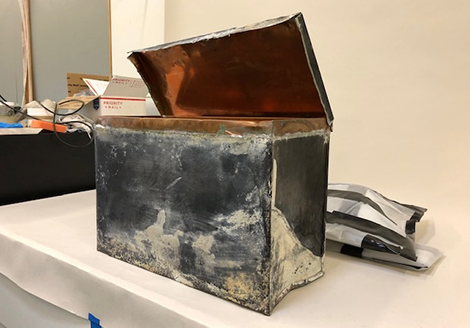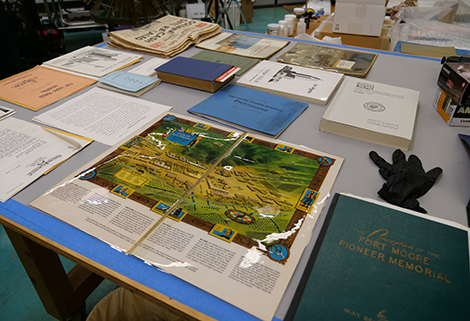It’s been over forty years, but the water is flowing again at the Fort Moore Pioneer Memorial. If you’ve ever driven on Hill Street between Chinatown and the Civic Center, you have passed by an 80-foot-wide tile wall flanked by a terra cotta bas relief of soldiers raising a flag on one side and a 237-foot long brick expanse on the other. Unknown to many, this is the Fort Moore Pioneer Memorial. Water used to cascade over the tile wall before it was turned off in 1977 in the midst of an extended drought.
It’s the most historically and geographically important monument that nobody knows about. It’s where Los Angeles really began.—Clare Haggerty, former Deputy Director of Collections, County Arts Commission
The Fort Moore Pioneer Memorial commemorates the first time the American flag was raised over Los Angeles. On July 4, 1847, members of the Mormon Battalion and the New York Volunteers hoisted a flag made from flannel, muslin, and an old petticoat up a 100-foot-tall flagpole.
Though no trace of it remains, Fort Moore was the first American fort built in Southern California. The signing of the Treaty of Cahuenga in January 1847 effectively ended fighting in the Mexican American War, but American forces were still wary of local resistance to their occupation when Colonel George Cooke ordered the construction of a permanent fort on April 24, 1847. The design called for a 400-foot long battlement, with ramparts for six cannons. Curiously, the rear of the fort was left entirely unenclosed. The work was done by the U.S. First Dragoons, New York Volunteers, and the Mormon Battalion, the only religious unit in U.S. military history.
On July 4th, 1847, the first formal observance of the fourth of July in Los Angeles was held at the fort. During the ceremony, the fort was named in honor of Army Captain Benjamin Moore of the First Dragoons (killed by a lance during the Battle of San Pascual), the Declaration of Independence was read in English and Spanish, and the American flag was raised over the newly-conquered California territory.
The Mexican American War officially ended with the signing of the Treaty of Hidalgo in February 1848. Shortly thereafter, the never-completed Fort Moore was abandoned as a military post. It was officially decommissioned in 1853. Over the years, a cemetery, a beer hall, fancy Victorian homes, a parking lot, and a high school were all built over and around the remains of the fort.
In the early thirties, over 260,000 cubic yards of dirt were hauled away by donkey carts to the Union Station construction site. In 1949, most of what was left of Fort Moore Hill was removed to make way for the 101 Freeway.
The Fort Moore Pioneer Memorial was the brainchild of May Belle Davis, a member of the Daughters of the Utah Pioneers. Davis’ great grandfather was part of the Mormon Battalion. In the early thirties, she began campaigning for a Mormon Battalion monument at the site of Fort Moore. The Depression and World War II stalled her efforts, but after 25 years she was finally able to gain approval from the county for the memorial. The groundbreaking ceremony was held on July 13, 1953.
The design for the memorial was created by local architects Kazumi Adachi and Dike Nagano. Sitting on what remains of Fort Moore Hill, the memorial’s design was, out of necessity, part retaining wall.
The monument design consists of the 80-foot wide tile fountain, the 78-foot by 45-foot bas relief, a 279-foot-long brick facade and a 68-foot-tall pylon. Sculptor Henry Kreis won the competition to design the bas relief depicting the flag raising ceremony. Kreis consulted with historians to make sure historical details such as the depiction of the military uniforms were accurate. He also designed the three smaller relief panels representing the ranchos, American settlers, and the development of water and power. It should be noted that the DWP was one of the sponsors of the memorial. Renowned California terra cotta manufacturer Gladding, McBean fabricated the panels for the wall.
Sculptor Albert Stewart designed the 68-foot pylon embossed with a sculpted eagle and an inscription. Stewart taught at Scripps College for 25 years.
The forty years since the water was turned off were not kind to the memorial. It suffered years of neglect and vandalism. The waterfall tiles became brittle and fell off, the plumbing system decayed, and the brick wall was scarred with graffiti.
After approving $1.4 million for the work, Los Angeles County has been carefully restoring the long-neglected the memorial for nearly five years. The prep work started in 2014 and construction began in 2016.

Overseeing the painstaking work was Clare Haggarty, former Deputy Director of Collections of the County Arts Commission, and Conservator Donna Williams. Williams also led, supervised the restoration of Hollyhock House and the Hall of Justice.
All of the nearly 300,000 tiles behind the waterfall had to be replaced. The one by two-inch size is no longer standard, so each tile had to be hand cut. In addition, there was a great deal of back and forth to recreate the original tile colors. Previous attempts to remove the graffiti did more harm than good. All of the plumbing had to be replaced, but as many of the original elements that could be saved were preserved.
During the restoration, a time capsule placed in the flag pole during the 1958 dedication was discovered. The capsule itself was handcrafted from copper sheeting and soldered shut.

Inside the time capsule were photographs, newspapers, county documents, and papers and brochures related to the Fort Moore Pioneer Memorial. The contents were amazingly well preserved.

A new time capsule will be installed at the rededication. Public contributions were sought for inclusion in the 2019 time capsule.
The area surrounding the monument is also being revived. The Fort Moore Memorial used to be isolated, sitting across Hill Street from a parking lot and bounded by the 101 freeway on the south and Cesar Chavez Avenue on the north, but now it lies at the western edge of LA Plaza Village. When completed, the mixed-use development will contain a central walkway that connects the memorial with Olvera Street.

After all the hard work, the barricades are down and the memorial is spruced up and ready for its second act. The grand rededication was held on July 3rd, the 61st anniversary of the dedication of the Fort Moore Pioneer Memorial.









